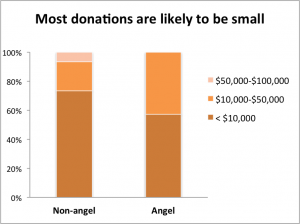We’re well into the era when dwindling venture capital is no longer the first or best option for raising money to seed a new company or fund through the Valley of Death. At Nelsen BioMedical, we advise clients on alternative sources of cash. At the recent RESI (Redefining Early Stage Investments) conference in Boston, we heard a discussion about crowdfunding, and we thought we’d take a closer look at the feasibility of this option.
There are two type of crowdfunding – equity-based and donation-based. Among equity-based crowdfunding sites, few dabble in life science, although healthcare-focused Medstartr stands out. But neither Medstartr nor other sites such as Seedinvest, Fundersclub, and Microventures list any fundraising campaigns in the therapeutics R&D space. Current sentiment is that equity-based crowdfunding is potentially a viable option for companies with low capital requirements. In contrast, life science companies (especially those focused on therapeutics) are capital-intensive, requiring multiple rounds of fundraising over many years to make progress. This means the earliest investors’ equity stake is often diluted to a very minimal value. This alone makes equity-based crowdfunding an unlikely source of capital for the life sciences outside of software- and IT-focused organizations.
On the other hand, there’s donation-based crowdfunding. One example in the life science space is Beats of Laughter, launched this past summer. This nonprofit organization aims to raise funds, through donations, for companies that focus on cancer therapies. Like equity-based sites, donation-based crowdfunding sites typically attract small individual donations. Campaigns that raise $5M are the exception rather than the rule. This makes it unlikely that donation-based crowdfunding would raise the kind of cash that a new life science company would need and would typically raise through an initial angel round ($0.5M first round size, according to a recent Halo report). However, crowdfunding in combination with a “family and friends” round could raise sufficient capital to achieve the kind of milestones that attract a subsequent, bigger round of angel investors.
To learn more about what people think about donation-based crowdfunding, we polled 25 individuals who identified as either being life science angel investors (9) or not (16). All reported contributing to charities or nonprofits.
The donation-based life science funding model was attractive to 72% of the respondents – however, this was heavily skewed toward non-angels, 87% of whom found the model “somewhat” or “very” attractive. More than half of the angels did not.
Irrespective of their likelihood to donate, both types of respondents cited the advantages of (1) funding companies with potential cures and solutions they would not otherwise have had access to or known about; (2) funding at lower thresholds than they would as individual angel investors; (3) using dollars from their charitable giving allotment in a more directed way; and (4) receiving a tax deduction (for example, a contribution of $20,000 can potentially yield a $6,600 income tax deduction for individuals or couples in the 33% federal income tax bracket.)
When asked why they wouldn’t participate in a donation-based funding model, the angel investors overwhelmingly (89%) cited their preference for taking an equity stake in the companies they fund, with about half of them also citing the greater potential ROI of angel investing as compared to the tax benefits of donation. 
Finally, the majority of both types of respondents stated that they would likely donate $10,000 or less, with 80% donating less than $50,000. By our estimates, it would likely take at least dozen individual donors to raise a $100,000 round; assuming a more realistic donation size of $1,000, you’d need to attract 100 donors. Most angel investors will sit out, waiting until a company can show enough value for them to take an equity stake. So how do non-profit crowdfunding sites, and the start-ups who want to use them for fundraising, build their success?
For the donation-based crowdfunding sites like Beats of Laughter to succeed, they’ll need to address concerns expressed by some of our survey respondents about the novel nature of this funding model. Potential donors want confidence that the dollars raised will be used for start-ups to show results, rather than for the crowdfunding site’s overhead. Donation-based crowdfunding sites will need to show their commitment to execute to plan, as well as the ability to effectively screen candidate companies and perform due diligence, ideally leveraging recognized leaders in the field. Crowdfunding in general will need to allay funders’ trepidation about the risk of fraud.
Companies should consider using donation-based crowdfunding to help them reach value-creating milestones that reduce risk and enhance confidence in the company’s ability to set and reach goals. This small amount of capital can increase the likelihood of a subsequent investment. For example, use the capital to hire an experienced CEO who has “done it before”; complete key proof-of-concept experiments; or leverage the capital to win SBIR funds. The crowdfunding option may be an attractive way to achieve a non-dilutive raise to attract “matching” investments.
Time will tell, but at present, donation-based crowdfunding seems a more viable option for life science companies than equity-based. It provides those who give to charity the ability to directly fund companies focused in areas in which the donor has a personal interest. And though the capital raised is small, it may be sufficient for life science start-ups to move closer to a milestone meaningful for angel investors, and provide an initial conduit between a critical innovation and company formation.
Tell us your thoughts. Do you think crowdfunding has a place in the life science industry? Would you participate – as a company or a funder? Leave your comments below!





